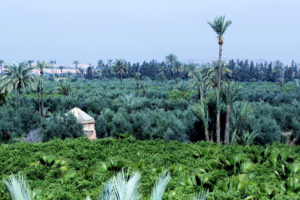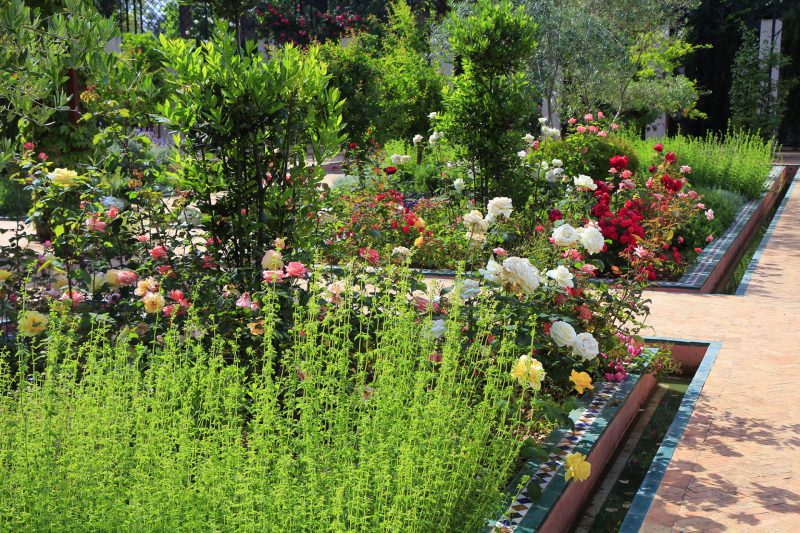 Arabic gardens or Islamic gardens? This is the first question that comes to mind regarding the gardens that were created from the 7th century until the decline of the Ottoman Empire, gardens that offer playful shadows, fragrant flowerbeds arranged in careful disorder, babbling fountains with jets and ponds, and delightful pavilions. “Islamic” is undoubtedly the right epithet for the Al-Andalús, Turkish or Mughal gardens, direct or indirect heirs to the Persian tradition, one which has little to do with the Arabic tradition that reached a bare 13% of the Muslim universe.
Arabic gardens or Islamic gardens? This is the first question that comes to mind regarding the gardens that were created from the 7th century until the decline of the Ottoman Empire, gardens that offer playful shadows, fragrant flowerbeds arranged in careful disorder, babbling fountains with jets and ponds, and delightful pavilions. “Islamic” is undoubtedly the right epithet for the Al-Andalús, Turkish or Mughal gardens, direct or indirect heirs to the Persian tradition, one which has little to do with the Arabic tradition that reached a bare 13% of the Muslim universe.
Keys to the Persian garden concept are broad avenues and open spaces, with canals and pavilions for relaxation. Over the centuries, different characteristics developed, taken from the cultures with which Islam came into contact. The most singular type of Al-Andalús garden was the walled patio, stemming from the Semitic tradition of the hortus conclusus but not without influence from the Roman peristyle. Such gardens also emulated the Koranic concept of paradise devoted to spiritual wellbeing, with plants, fruits and shade being offered as a reward for elevated souls.
The most singular type of Al-Andalús garden was the walled patio, stemming from the Semitic tradition of the hortus conclusus but not without influence from the Roman peristyle.
To some extent, the closed Islamic garden was also the antithesis of the desert and the outdoors that characterised the Arabian peninsula, the cradle of Islam. It was protected, finite, welcoming, verdant, and in it water held pride of place.
Elements of Islamic gardens
A genuine Islamic garden has the following elements: symmetry, channels and fountains in which the sound of water has a calming effect, and still pools reflecting architecture in order to duplicate the feeling of space and to cool the air.
The flowerbeds are arranged in the form of a cross, reminiscent of the four rivers of the Muslim (and evangelical) paradise, and sometimes below the level of the paths so that the vegetation can be fully appreciated by the senses. The plants must be aromatic and flowering and freely but wisely combined with fruiting plants. Sometimes hedges or bushes are trimmed into fantasy shapes. Architectural elements are also important, allowing enjoyment of the garden from above while also affording shade – pergolas, colonnades, or pavilions made from a variety of materials. Sometimes, when the area is large, the space might be arranged in broad, stepped levels so that the property can be viewed panoramically, with the emphasis on the “power garden”. To paraphrase architect Fernando Chueca Goitia, “an Arab (and, in this case, a Muslim) is a person who likes to spend his life sitting in a garden”.
The best examples
 Some of the most spectacular Islamic gardens are to be found in the Alhambra and Generalife in Granada, although there are also other examples off the beaten track: the Casa de la Contratación in Seville, the Casa del Gigante in Ronda or the Aljafería Palace in Zaragoza. Outstanding examples are to be found in the Menara in Marrakesh, dating from the Almohad period but with subsequent rather unsuccessful alterations, and the Agdal gardens also in Marrakesh dating from the 12th century, with about 914 acres of plants and ponds. This is probably the world’s oldest and largest Islamic (or Berber?) garden.
Some of the most spectacular Islamic gardens are to be found in the Alhambra and Generalife in Granada, although there are also other examples off the beaten track: the Casa de la Contratación in Seville, the Casa del Gigante in Ronda or the Aljafería Palace in Zaragoza. Outstanding examples are to be found in the Menara in Marrakesh, dating from the Almohad period but with subsequent rather unsuccessful alterations, and the Agdal gardens also in Marrakesh dating from the 12th century, with about 914 acres of plants and ponds. This is probably the world’s oldest and largest Islamic (or Berber?) garden.
Some of the most spectacular Islamic gardens are to be found in the Alhambra and Generalife in Granada, although there are also other examples off the beaten track: the Casa de la Contratación in Seville, the Casa del Gigante in Ronda or the Aljafería Palace in Zaragoza.
Different but no less spectacular are the Iranian gardens at the Madraza-ye Chahar Bagh and Bagh-e Shahzadeh, as well as the Ottoman gardens in Turkey and the Mughal (17-18th century) gardens in Shalimar (Pakistan) and the Taj Mahal in India.
State of conservation
Some of these gardens, such as those in Spain, are in a fairly good state of repair. At others, such as the Agdal in Marrakesh, restoration is being planned in a way that respects both the cultural heritage and biodiversity. The Isfahan gardens in Iran, those in the Topkapi palace in Istanbul and the Shalimar gardens in Lahore, some of which are on the UNESCO Heritage of Mankind list, are well conserved. However, the concept of historical garden restoration is controversial, because a garden, unlike a monument, is alive and constantly changing. It is like a body that breathes and is transformed over the centuries.
The fact is that most Islamic gardens are in a state of relative neglect or have been inappropriately altered. The current socio-economic situation of the Muslim-majority countries makes it impossible to devote much attention to restoring the heritage. There are practically no figures for protection, and assistance has been sought from international organisations such as UNESCO in just a very few cases.
However, some private initiatives and certain international programmes for cooperation are working to safeguard this legacy. One such is FUNCI’s international programme, “Med-O-Med, cultural landscapes of the Mediterranean and the Middle East”, which focuses on recovery of the historical landscape, gardens and biodiversity in these regions. Some actions are already under way involving partners on both sides of the Mare Nostrum.
This post is available in: English Español



